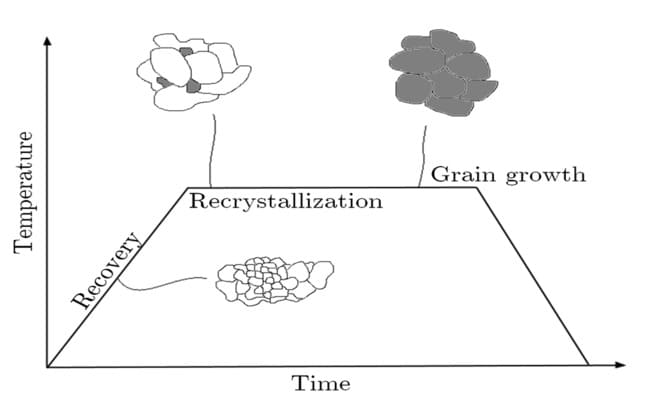Annealing is a widely recognized heat treatment process specifically designed for soft metals. Its main objective is to enhance the ductility of metals, enabling them to be shaped and formed more efficiently. This article explores the three primary stages of the annealing process and their significance in restoring the original properties of materials.
Annealing Stages:
The three important stages of Annealing process are:
- Recovery Stage,
- Recrystallization Stage,
- Grain Growth Stage.

1. Recovery Stage
- Recovery Stage: During the recovery stage of annealing, the physical properties of metals are restored. This includes the recovery of electrical conductivity, internal energy, and thermal expansion. By subjecting the materials to elevated temperatures using a furnace or heating devices, the metals are softened, relieving them of internal stresses.
Example: When a metal undergoes bending, cold forming, or drawing processes, it tends to lose its ductility. Through the recovery stage of annealing, the metal can regain its original properties, allowing for further shaping and forming.
2. Recrystallization Stage
- Recrystallization Stage: The recrystallization stage is a restorative process where materials are heated above their recrystallization temperature but below their melting point. During this stage, deformed grains of the metal’s crystal structures are replaced with new stress-free grains, which were formed during the recovery stage. As stress-free cells nucleate and grow, the materials acquire new grains without residual stresses.
Example: Mild steel products can be effectively softened at temperatures ranging from 500 to 650°C, eliminating any deformations caused by previous processes.
Grain Growth Stage
- Grain Growth Stage: Following the recrystallization stage, the materials often undergo the grain growth stage. During this stage, the microstructure of the metals becomes coarser as they cool down. Although the materials may experience a slight loss in strength, this can be regained through subsequent hardening processes such as quenching and tempering.
Example: After the annealing process, the metal may exhibit a coarser microstructure. However, by subjecting it to quenching and tempering, the lost strength can be restored.
Conclusion
Annealing is a crucial heat treatment process for soft metals, allowing them to regain their ductility and original properties. By understanding the three primary stages of annealing – recovery, recrystallization, and grain growth – manufacturers can effectively shape and form metals, ensuring optimal performance in various applications.
